HRM Effectiveness: Benefits, Practices, and Organizational Impact
VerifiedAdded on 2022/01/18
|6
|2750
|64
Report
AI Summary
This report evaluates the effectiveness of key Human Resource Management (HRM) elements within an organization, focusing on workplace flexibility, training, rewards systems, and performance standards. It explores the benefits of these HRM practices from both the employee and employer perspectives, highlighting how they can increase an organization's profits and productivity. The report discusses various aspects of workplace flexibility such as telecommuting, condensed workweeks, and part-time work, while also examining the importance of employee training and development in enhancing skills and adaptability. Furthermore, it analyzes the role of rewards systems, including compensation and incentives, in boosting employee morale and retention. The report also delves into performance standards, emphasizing their role in monitoring and evaluating employee work, and offers a personal perspective, supported by examples, on how these HRM practices contribute to a high-spirited, efficient, and effective work environment. The report concludes by emphasizing the critical role of training and development in fostering a productive and engaged workforce.
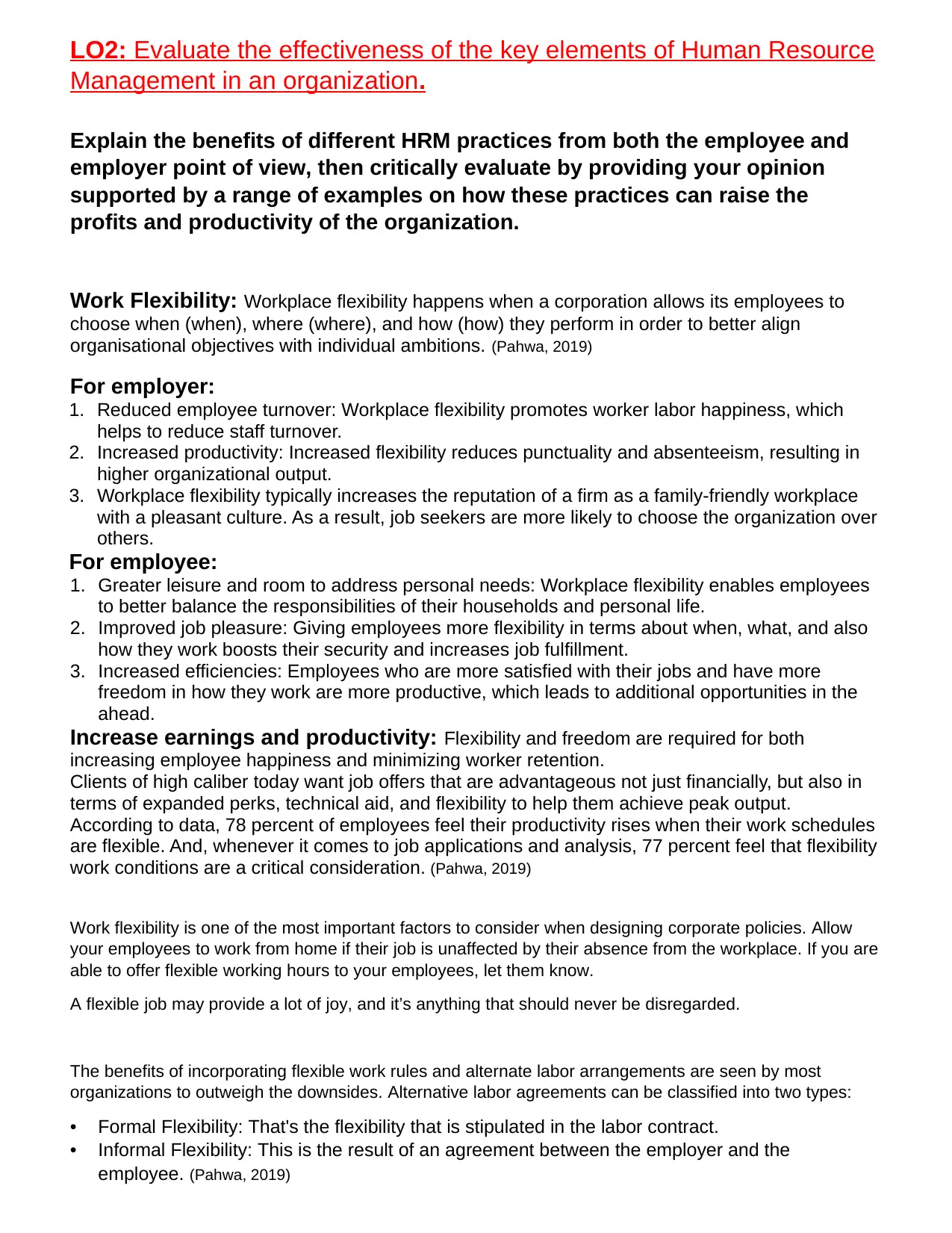
LO2: Evaluate the effectiveness of the key elements of Human Resource
Management in an organization.
Explain the benefits of different HRM practices from both the employee and
employer point of view, then critically evaluate by providing your opinion
supported by a range of examples on how these practices can raise the
profits and productivity of the organization.
Work Flexibility: Workplace flexibility happens when a corporation allows its employees to
choose when (when), where (where), and how (how) they perform in order to better align
organisational objectives with individual ambitions. (Pahwa, 2019)
For employer:
1. Reduced employee turnover: Workplace flexibility promotes worker labor happiness, which
helps to reduce staff turnover.
2. Increased productivity: Increased flexibility reduces punctuality and absenteeism, resulting in
higher organizational output.
3. Workplace flexibility typically increases the reputation of a firm as a family-friendly workplace
with a pleasant culture. As a result, job seekers are more likely to choose the organization over
others.
For employee:
1. Greater leisure and room to address personal needs: Workplace flexibility enables employees
to better balance the responsibilities of their households and personal life.
2. Improved job pleasure: Giving employees more flexibility in terms about when, what, and also
how they work boosts their security and increases job fulfillment.
3. Increased efficiencies: Employees who are more satisfied with their jobs and have more
freedom in how they work are more productive, which leads to additional opportunities in the
ahead.
Increase earnings and productivity: Flexibility and freedom are required for both
increasing employee happiness and minimizing worker retention.
Clients of high caliber today want job offers that are advantageous not just financially, but also in
terms of expanded perks, technical aid, and flexibility to help them achieve peak output.
According to data, 78 percent of employees feel their productivity rises when their work schedules
are flexible. And, whenever it comes to job applications and analysis, 77 percent feel that flexibility
work conditions are a critical consideration. (Pahwa, 2019)
Work flexibility is one of the most important factors to consider when designing corporate policies. Allow
your employees to work from home if their job is unaffected by their absence from the workplace. If you are
able to offer flexible working hours to your employees, let them know.
A flexible job may provide a lot of joy, and it’s anything that should never be disregarded.
The benefits of incorporating flexible work rules and alternate labor arrangements are seen by most
organizations to outweigh the downsides. Alternative labor agreements can be classified into two types:
• Formal Flexibility: That's the flexibility that is stipulated in the labor contract.
• Informal Flexibility: This is the result of an agreement between the employer and the
employee. (Pahwa, 2019)
Management in an organization.
Explain the benefits of different HRM practices from both the employee and
employer point of view, then critically evaluate by providing your opinion
supported by a range of examples on how these practices can raise the
profits and productivity of the organization.
Work Flexibility: Workplace flexibility happens when a corporation allows its employees to
choose when (when), where (where), and how (how) they perform in order to better align
organisational objectives with individual ambitions. (Pahwa, 2019)
For employer:
1. Reduced employee turnover: Workplace flexibility promotes worker labor happiness, which
helps to reduce staff turnover.
2. Increased productivity: Increased flexibility reduces punctuality and absenteeism, resulting in
higher organizational output.
3. Workplace flexibility typically increases the reputation of a firm as a family-friendly workplace
with a pleasant culture. As a result, job seekers are more likely to choose the organization over
others.
For employee:
1. Greater leisure and room to address personal needs: Workplace flexibility enables employees
to better balance the responsibilities of their households and personal life.
2. Improved job pleasure: Giving employees more flexibility in terms about when, what, and also
how they work boosts their security and increases job fulfillment.
3. Increased efficiencies: Employees who are more satisfied with their jobs and have more
freedom in how they work are more productive, which leads to additional opportunities in the
ahead.
Increase earnings and productivity: Flexibility and freedom are required for both
increasing employee happiness and minimizing worker retention.
Clients of high caliber today want job offers that are advantageous not just financially, but also in
terms of expanded perks, technical aid, and flexibility to help them achieve peak output.
According to data, 78 percent of employees feel their productivity rises when their work schedules
are flexible. And, whenever it comes to job applications and analysis, 77 percent feel that flexibility
work conditions are a critical consideration. (Pahwa, 2019)
Work flexibility is one of the most important factors to consider when designing corporate policies. Allow
your employees to work from home if their job is unaffected by their absence from the workplace. If you are
able to offer flexible working hours to your employees, let them know.
A flexible job may provide a lot of joy, and it’s anything that should never be disregarded.
The benefits of incorporating flexible work rules and alternate labor arrangements are seen by most
organizations to outweigh the downsides. Alternative labor agreements can be classified into two types:
• Formal Flexibility: That's the flexibility that is stipulated in the labor contract.
• Informal Flexibility: This is the result of an agreement between the employer and the
employee. (Pahwa, 2019)
Paraphrase This Document
Need a fresh take? Get an instant paraphrase of this document with our AI Paraphraser
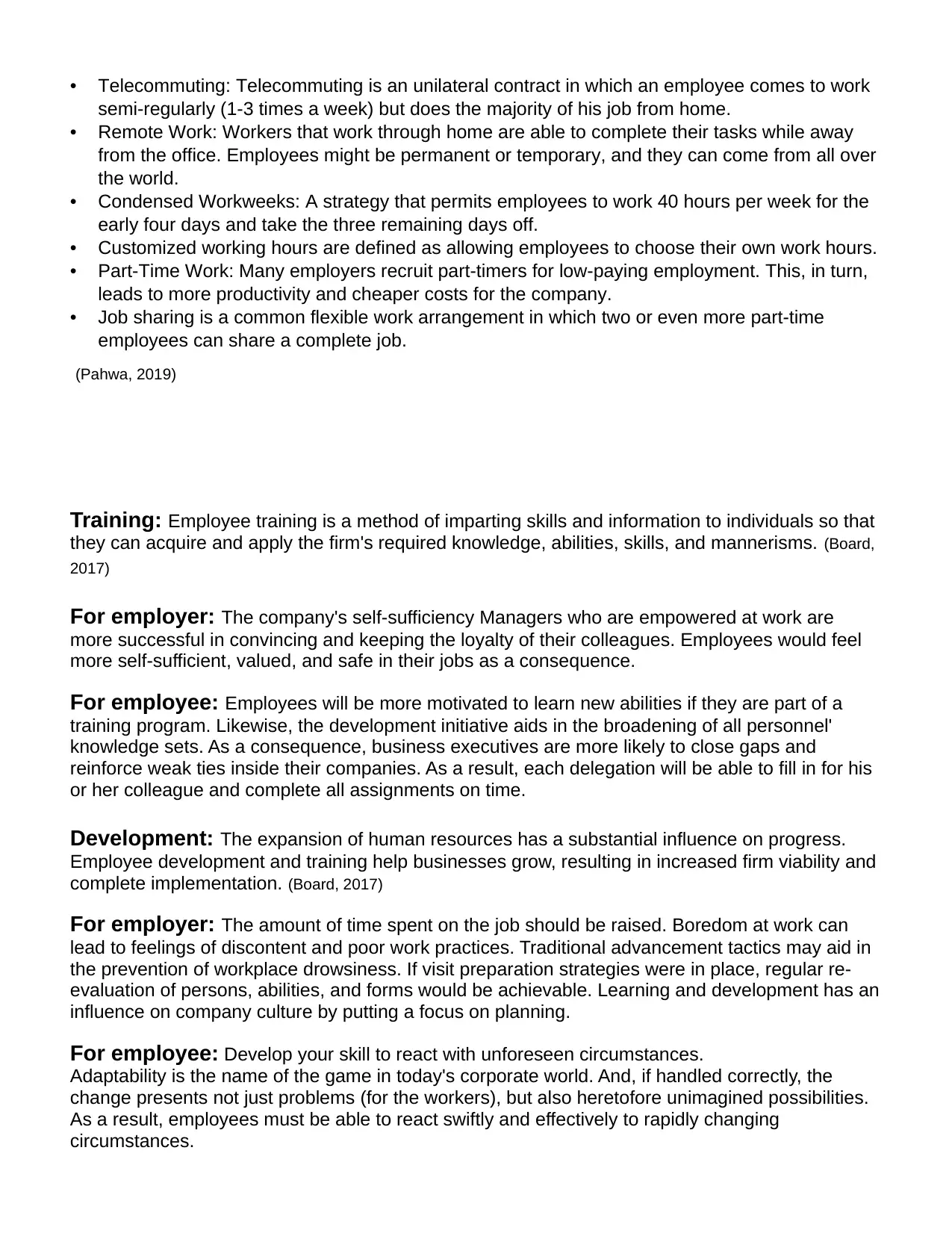
• Telecommuting: Telecommuting is an unilateral contract in which an employee comes to work
semi-regularly (1-3 times a week) but does the majority of his job from home.
• Remote Work: Workers that work through home are able to complete their tasks while away
from the office. Employees might be permanent or temporary, and they can come from all over
the world.
• Condensed Workweeks: A strategy that permits employees to work 40 hours per week for the
early four days and take the three remaining days off.
• Customized working hours are defined as allowing employees to choose their own work hours.
• Part-Time Work: Many employers recruit part-timers for low-paying employment. This, in turn,
leads to more productivity and cheaper costs for the company.
• Job sharing is a common flexible work arrangement in which two or even more part-time
employees can share a complete job.
(Pahwa, 2019)
Training: Employee training is a method of imparting skills and information to individuals so that
they can acquire and apply the firm's required knowledge, abilities, skills, and mannerisms. (Board,
2017)
For employer: The company's self-sufficiency Managers who are empowered at work are
more successful in convincing and keeping the loyalty of their colleagues. Employees would feel
more self-sufficient, valued, and safe in their jobs as a consequence.
For employee: Employees will be more motivated to learn new abilities if they are part of a
training program. Likewise, the development initiative aids in the broadening of all personnel'
knowledge sets. As a consequence, business executives are more likely to close gaps and
reinforce weak ties inside their companies. As a result, each delegation will be able to fill in for his
or her colleague and complete all assignments on time.
Development: The expansion of human resources has a substantial influence on progress.
Employee development and training help businesses grow, resulting in increased firm viability and
complete implementation. (Board, 2017)
For employer: The amount of time spent on the job should be raised. Boredom at work can
lead to feelings of discontent and poor work practices. Traditional advancement tactics may aid in
the prevention of workplace drowsiness. If visit preparation strategies were in place, regular re-
evaluation of persons, abilities, and forms would be achievable. Learning and development has an
influence on company culture by putting a focus on planning.
For employee: Develop your skill to react with unforeseen circumstances.
Adaptability is the name of the game in today's corporate world. And, if handled correctly, the
change presents not just problems (for the workers), but also heretofore unimagined possibilities.
As a result, employees must be able to react swiftly and effectively to rapidly changing
circumstances.
semi-regularly (1-3 times a week) but does the majority of his job from home.
• Remote Work: Workers that work through home are able to complete their tasks while away
from the office. Employees might be permanent or temporary, and they can come from all over
the world.
• Condensed Workweeks: A strategy that permits employees to work 40 hours per week for the
early four days and take the three remaining days off.
• Customized working hours are defined as allowing employees to choose their own work hours.
• Part-Time Work: Many employers recruit part-timers for low-paying employment. This, in turn,
leads to more productivity and cheaper costs for the company.
• Job sharing is a common flexible work arrangement in which two or even more part-time
employees can share a complete job.
(Pahwa, 2019)
Training: Employee training is a method of imparting skills and information to individuals so that
they can acquire and apply the firm's required knowledge, abilities, skills, and mannerisms. (Board,
2017)
For employer: The company's self-sufficiency Managers who are empowered at work are
more successful in convincing and keeping the loyalty of their colleagues. Employees would feel
more self-sufficient, valued, and safe in their jobs as a consequence.
For employee: Employees will be more motivated to learn new abilities if they are part of a
training program. Likewise, the development initiative aids in the broadening of all personnel'
knowledge sets. As a consequence, business executives are more likely to close gaps and
reinforce weak ties inside their companies. As a result, each delegation will be able to fill in for his
or her colleague and complete all assignments on time.
Development: The expansion of human resources has a substantial influence on progress.
Employee development and training help businesses grow, resulting in increased firm viability and
complete implementation. (Board, 2017)
For employer: The amount of time spent on the job should be raised. Boredom at work can
lead to feelings of discontent and poor work practices. Traditional advancement tactics may aid in
the prevention of workplace drowsiness. If visit preparation strategies were in place, regular re-
evaluation of persons, abilities, and forms would be achievable. Learning and development has an
influence on company culture by putting a focus on planning.
For employee: Develop your skill to react with unforeseen circumstances.
Adaptability is the name of the game in today's corporate world. And, if handled correctly, the
change presents not just problems (for the workers), but also heretofore unimagined possibilities.
As a result, employees must be able to react swiftly and effectively to rapidly changing
circumstances.
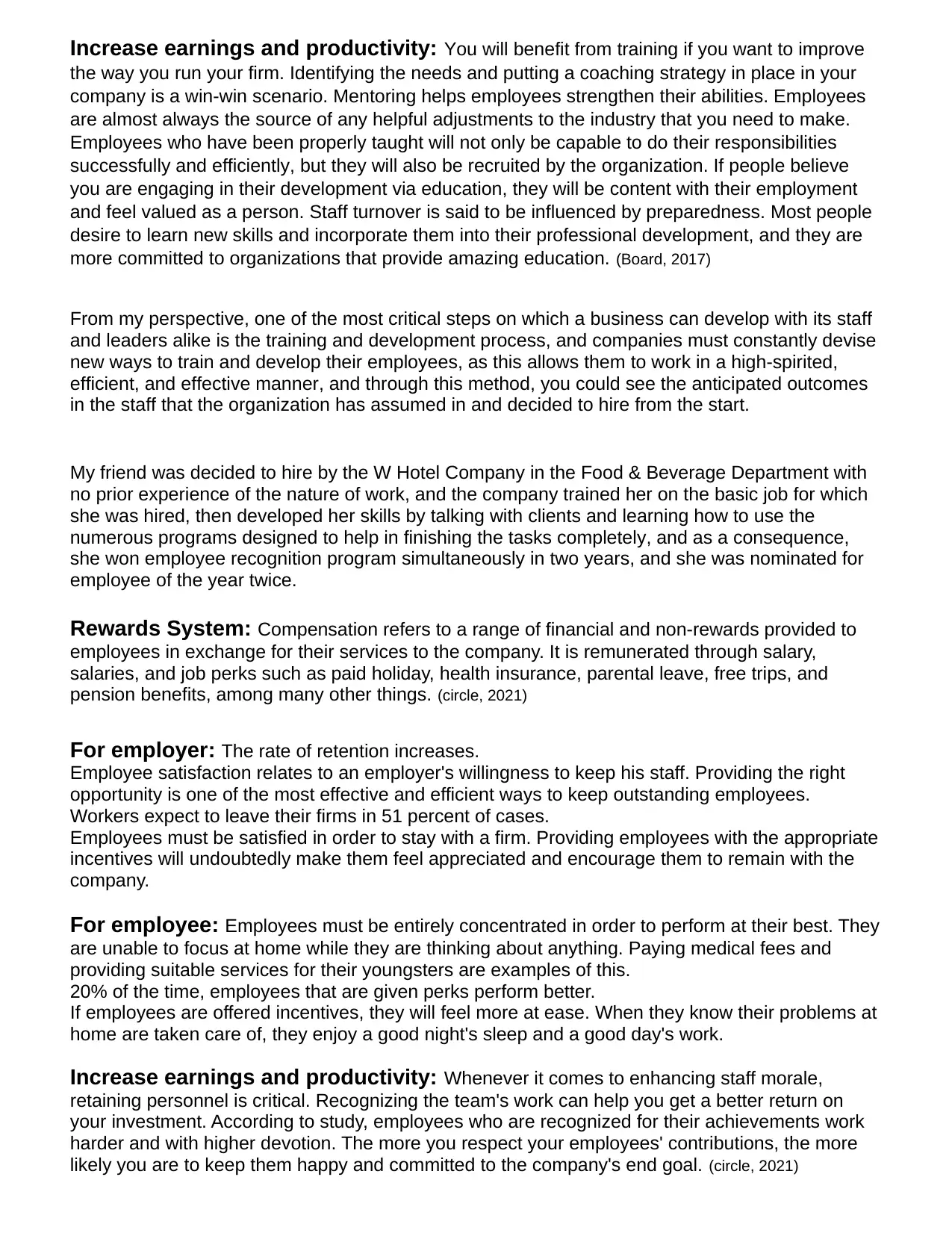
Increase earnings and productivity: You will benefit from training if you want to improve
the way you run your firm. Identifying the needs and putting a coaching strategy in place in your
company is a win-win scenario. Mentoring helps employees strengthen their abilities. Employees
are almost always the source of any helpful adjustments to the industry that you need to make.
Employees who have been properly taught will not only be capable to do their responsibilities
successfully and efficiently, but they will also be recruited by the organization. If people believe
you are engaging in their development via education, they will be content with their employment
and feel valued as a person. Staff turnover is said to be influenced by preparedness. Most people
desire to learn new skills and incorporate them into their professional development, and they are
more committed to organizations that provide amazing education. (Board, 2017)
From my perspective, one of the most critical steps on which a business can develop with its staff
and leaders alike is the training and development process, and companies must constantly devise
new ways to train and develop their employees, as this allows them to work in a high-spirited,
efficient, and effective manner, and through this method, you could see the anticipated outcomes
in the staff that the organization has assumed in and decided to hire from the start.
My friend was decided to hire by the W Hotel Company in the Food & Beverage Department with
no prior experience of the nature of work, and the company trained her on the basic job for which
she was hired, then developed her skills by talking with clients and learning how to use the
numerous programs designed to help in finishing the tasks completely, and as a consequence,
she won employee recognition program simultaneously in two years, and she was nominated for
employee of the year twice.
Rewards System: Compensation refers to a range of financial and non-rewards provided to
employees in exchange for their services to the company. It is remunerated through salary,
salaries, and job perks such as paid holiday, health insurance, parental leave, free trips, and
pension benefits, among many other things. (circle, 2021)
For employer: The rate of retention increases.
Employee satisfaction relates to an employer's willingness to keep his staff. Providing the right
opportunity is one of the most effective and efficient ways to keep outstanding employees.
Workers expect to leave their firms in 51 percent of cases.
Employees must be satisfied in order to stay with a firm. Providing employees with the appropriate
incentives will undoubtedly make them feel appreciated and encourage them to remain with the
company.
For employee: Employees must be entirely concentrated in order to perform at their best. They
are unable to focus at home while they are thinking about anything. Paying medical fees and
providing suitable services for their youngsters are examples of this.
20% of the time, employees that are given perks perform better.
If employees are offered incentives, they will feel more at ease. When they know their problems at
home are taken care of, they enjoy a good night's sleep and a good day's work.
Increase earnings and productivity: Whenever it comes to enhancing staff morale,
retaining personnel is critical. Recognizing the team's work can help you get a better return on
your investment. According to study, employees who are recognized for their achievements work
harder and with higher devotion. The more you respect your employees' contributions, the more
likely you are to keep them happy and committed to the company's end goal. (circle, 2021)
the way you run your firm. Identifying the needs and putting a coaching strategy in place in your
company is a win-win scenario. Mentoring helps employees strengthen their abilities. Employees
are almost always the source of any helpful adjustments to the industry that you need to make.
Employees who have been properly taught will not only be capable to do their responsibilities
successfully and efficiently, but they will also be recruited by the organization. If people believe
you are engaging in their development via education, they will be content with their employment
and feel valued as a person. Staff turnover is said to be influenced by preparedness. Most people
desire to learn new skills and incorporate them into their professional development, and they are
more committed to organizations that provide amazing education. (Board, 2017)
From my perspective, one of the most critical steps on which a business can develop with its staff
and leaders alike is the training and development process, and companies must constantly devise
new ways to train and develop their employees, as this allows them to work in a high-spirited,
efficient, and effective manner, and through this method, you could see the anticipated outcomes
in the staff that the organization has assumed in and decided to hire from the start.
My friend was decided to hire by the W Hotel Company in the Food & Beverage Department with
no prior experience of the nature of work, and the company trained her on the basic job for which
she was hired, then developed her skills by talking with clients and learning how to use the
numerous programs designed to help in finishing the tasks completely, and as a consequence,
she won employee recognition program simultaneously in two years, and she was nominated for
employee of the year twice.
Rewards System: Compensation refers to a range of financial and non-rewards provided to
employees in exchange for their services to the company. It is remunerated through salary,
salaries, and job perks such as paid holiday, health insurance, parental leave, free trips, and
pension benefits, among many other things. (circle, 2021)
For employer: The rate of retention increases.
Employee satisfaction relates to an employer's willingness to keep his staff. Providing the right
opportunity is one of the most effective and efficient ways to keep outstanding employees.
Workers expect to leave their firms in 51 percent of cases.
Employees must be satisfied in order to stay with a firm. Providing employees with the appropriate
incentives will undoubtedly make them feel appreciated and encourage them to remain with the
company.
For employee: Employees must be entirely concentrated in order to perform at their best. They
are unable to focus at home while they are thinking about anything. Paying medical fees and
providing suitable services for their youngsters are examples of this.
20% of the time, employees that are given perks perform better.
If employees are offered incentives, they will feel more at ease. When they know their problems at
home are taken care of, they enjoy a good night's sleep and a good day's work.
Increase earnings and productivity: Whenever it comes to enhancing staff morale,
retaining personnel is critical. Recognizing the team's work can help you get a better return on
your investment. According to study, employees who are recognized for their achievements work
harder and with higher devotion. The more you respect your employees' contributions, the more
likely you are to keep them happy and committed to the company's end goal. (circle, 2021)
⊘ This is a preview!⊘
Do you want full access?
Subscribe today to unlock all pages.

Trusted by 1+ million students worldwide
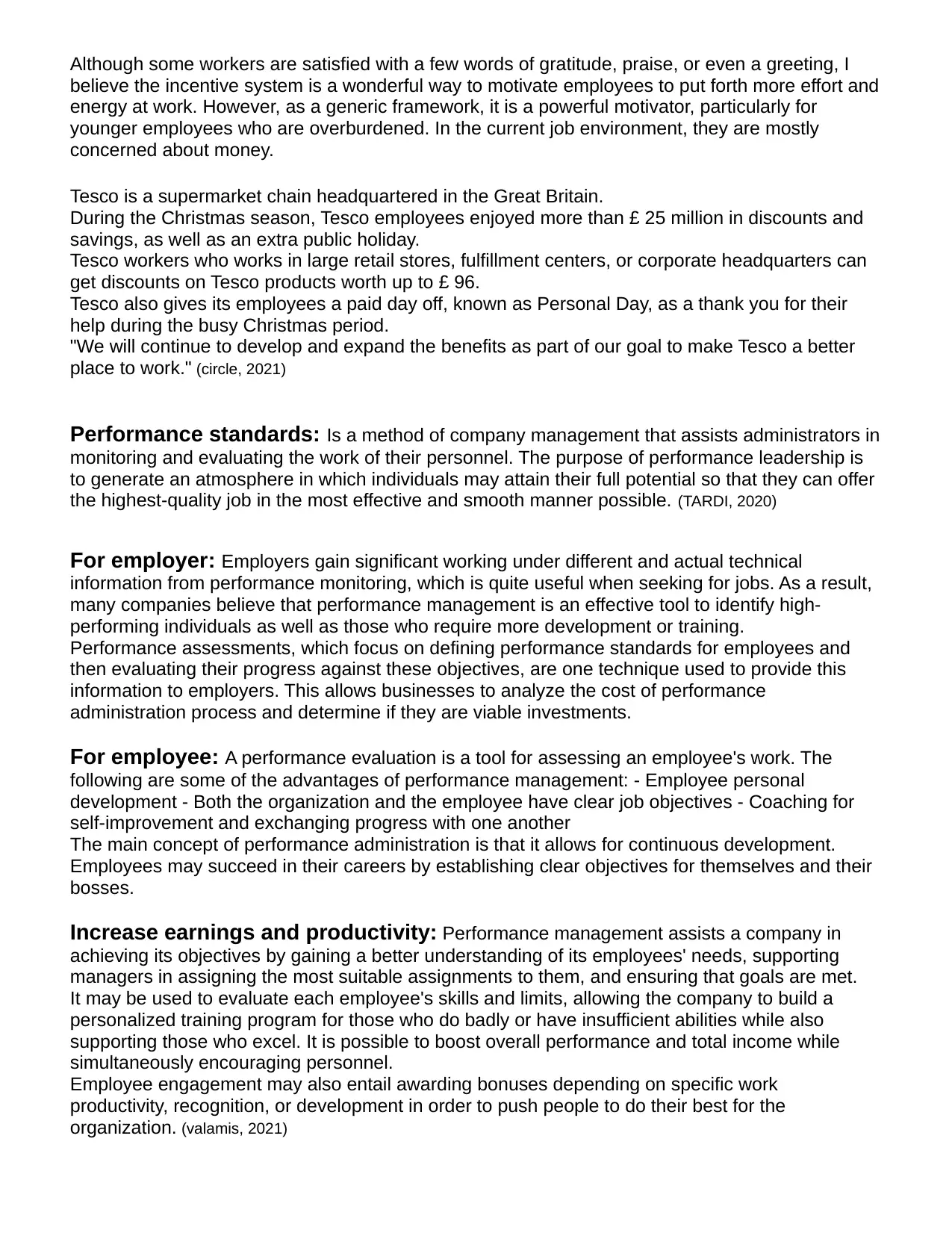
Although some workers are satisfied with a few words of gratitude, praise, or even a greeting, I
believe the incentive system is a wonderful way to motivate employees to put forth more effort and
energy at work. However, as a generic framework, it is a powerful motivator, particularly for
younger employees who are overburdened. In the current job environment, they are mostly
concerned about money.
Tesco is a supermarket chain headquartered in the Great Britain.
During the Christmas season, Tesco employees enjoyed more than £ 25 million in discounts and
savings, as well as an extra public holiday.
Tesco workers who works in large retail stores, fulfillment centers, or corporate headquarters can
get discounts on Tesco products worth up to £ 96.
Tesco also gives its employees a paid day off, known as Personal Day, as a thank you for their
help during the busy Christmas period.
"We will continue to develop and expand the benefits as part of our goal to make Tesco a better
place to work." (circle, 2021)
Performance standards: Is a method of company management that assists administrators in
monitoring and evaluating the work of their personnel. The purpose of performance leadership is
to generate an atmosphere in which individuals may attain their full potential so that they can offer
the highest-quality job in the most effective and smooth manner possible. (TARDI, 2020)
For employer: Employers gain significant working under different and actual technical
information from performance monitoring, which is quite useful when seeking for jobs. As a result,
many companies believe that performance management is an effective tool to identify high-
performing individuals as well as those who require more development or training.
Performance assessments, which focus on defining performance standards for employees and
then evaluating their progress against these objectives, are one technique used to provide this
information to employers. This allows businesses to analyze the cost of performance
administration process and determine if they are viable investments.
For employee: A performance evaluation is a tool for assessing an employee's work. The
following are some of the advantages of performance management: - Employee personal
development - Both the organization and the employee have clear job objectives - Coaching for
self-improvement and exchanging progress with one another
The main concept of performance administration is that it allows for continuous development.
Employees may succeed in their careers by establishing clear objectives for themselves and their
bosses.
Increase earnings and productivity: Performance management assists a company in
achieving its objectives by gaining a better understanding of its employees' needs, supporting
managers in assigning the most suitable assignments to them, and ensuring that goals are met.
It may be used to evaluate each employee's skills and limits, allowing the company to build a
personalized training program for those who do badly or have insufficient abilities while also
supporting those who excel. It is possible to boost overall performance and total income while
simultaneously encouraging personnel.
Employee engagement may also entail awarding bonuses depending on specific work
productivity, recognition, or development in order to push people to do their best for the
organization. (valamis, 2021)
believe the incentive system is a wonderful way to motivate employees to put forth more effort and
energy at work. However, as a generic framework, it is a powerful motivator, particularly for
younger employees who are overburdened. In the current job environment, they are mostly
concerned about money.
Tesco is a supermarket chain headquartered in the Great Britain.
During the Christmas season, Tesco employees enjoyed more than £ 25 million in discounts and
savings, as well as an extra public holiday.
Tesco workers who works in large retail stores, fulfillment centers, or corporate headquarters can
get discounts on Tesco products worth up to £ 96.
Tesco also gives its employees a paid day off, known as Personal Day, as a thank you for their
help during the busy Christmas period.
"We will continue to develop and expand the benefits as part of our goal to make Tesco a better
place to work." (circle, 2021)
Performance standards: Is a method of company management that assists administrators in
monitoring and evaluating the work of their personnel. The purpose of performance leadership is
to generate an atmosphere in which individuals may attain their full potential so that they can offer
the highest-quality job in the most effective and smooth manner possible. (TARDI, 2020)
For employer: Employers gain significant working under different and actual technical
information from performance monitoring, which is quite useful when seeking for jobs. As a result,
many companies believe that performance management is an effective tool to identify high-
performing individuals as well as those who require more development or training.
Performance assessments, which focus on defining performance standards for employees and
then evaluating their progress against these objectives, are one technique used to provide this
information to employers. This allows businesses to analyze the cost of performance
administration process and determine if they are viable investments.
For employee: A performance evaluation is a tool for assessing an employee's work. The
following are some of the advantages of performance management: - Employee personal
development - Both the organization and the employee have clear job objectives - Coaching for
self-improvement and exchanging progress with one another
The main concept of performance administration is that it allows for continuous development.
Employees may succeed in their careers by establishing clear objectives for themselves and their
bosses.
Increase earnings and productivity: Performance management assists a company in
achieving its objectives by gaining a better understanding of its employees' needs, supporting
managers in assigning the most suitable assignments to them, and ensuring that goals are met.
It may be used to evaluate each employee's skills and limits, allowing the company to build a
personalized training program for those who do badly or have insufficient abilities while also
supporting those who excel. It is possible to boost overall performance and total income while
simultaneously encouraging personnel.
Employee engagement may also entail awarding bonuses depending on specific work
productivity, recognition, or development in order to push people to do their best for the
organization. (valamis, 2021)
Paraphrase This Document
Need a fresh take? Get an instant paraphrase of this document with our AI Paraphraser
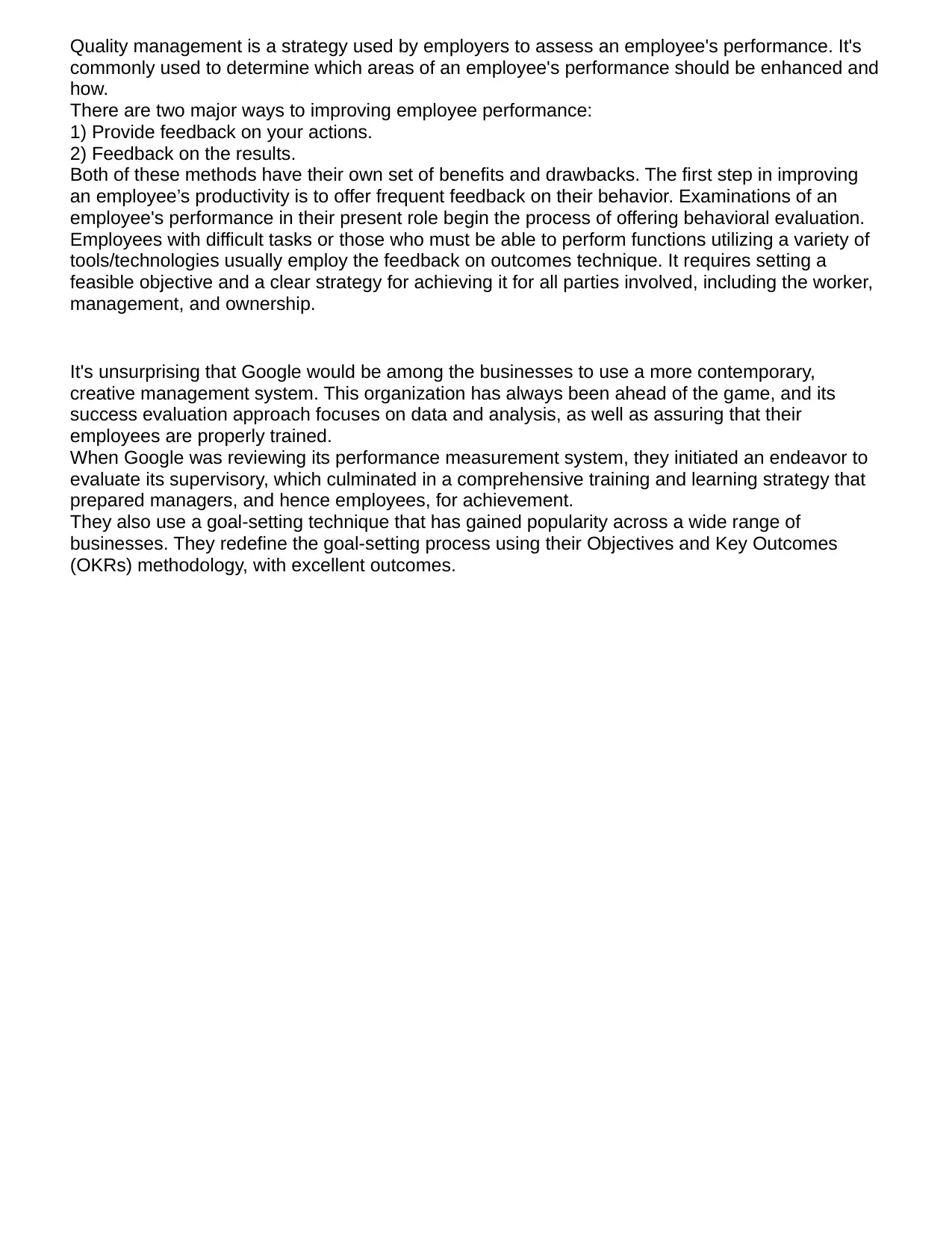
Quality management is a strategy used by employers to assess an employee's performance. It's
commonly used to determine which areas of an employee's performance should be enhanced and
how.
There are two major ways to improving employee performance:
1) Provide feedback on your actions.
2) Feedback on the results.
Both of these methods have their own set of benefits and drawbacks. The first step in improving
an employee’s productivity is to offer frequent feedback on their behavior. Examinations of an
employee's performance in their present role begin the process of offering behavioral evaluation.
Employees with difficult tasks or those who must be able to perform functions utilizing a variety of
tools/technologies usually employ the feedback on outcomes technique. It requires setting a
feasible objective and a clear strategy for achieving it for all parties involved, including the worker,
management, and ownership.
It's unsurprising that Google would be among the businesses to use a more contemporary,
creative management system. This organization has always been ahead of the game, and its
success evaluation approach focuses on data and analysis, as well as assuring that their
employees are properly trained.
When Google was reviewing its performance measurement system, they initiated an endeavor to
evaluate its supervisory, which culminated in a comprehensive training and learning strategy that
prepared managers, and hence employees, for achievement.
They also use a goal-setting technique that has gained popularity across a wide range of
businesses. They redefine the goal-setting process using their Objectives and Key Outcomes
(OKRs) methodology, with excellent outcomes.
commonly used to determine which areas of an employee's performance should be enhanced and
how.
There are two major ways to improving employee performance:
1) Provide feedback on your actions.
2) Feedback on the results.
Both of these methods have their own set of benefits and drawbacks. The first step in improving
an employee’s productivity is to offer frequent feedback on their behavior. Examinations of an
employee's performance in their present role begin the process of offering behavioral evaluation.
Employees with difficult tasks or those who must be able to perform functions utilizing a variety of
tools/technologies usually employ the feedback on outcomes technique. It requires setting a
feasible objective and a clear strategy for achieving it for all parties involved, including the worker,
management, and ownership.
It's unsurprising that Google would be among the businesses to use a more contemporary,
creative management system. This organization has always been ahead of the game, and its
success evaluation approach focuses on data and analysis, as well as assuring that their
employees are properly trained.
When Google was reviewing its performance measurement system, they initiated an endeavor to
evaluate its supervisory, which culminated in a comprehensive training and learning strategy that
prepared managers, and hence employees, for achievement.
They also use a goal-setting technique that has gained popularity across a wide range of
businesses. They redefine the goal-setting process using their Objectives and Key Outcomes
(OKRs) methodology, with excellent outcomes.
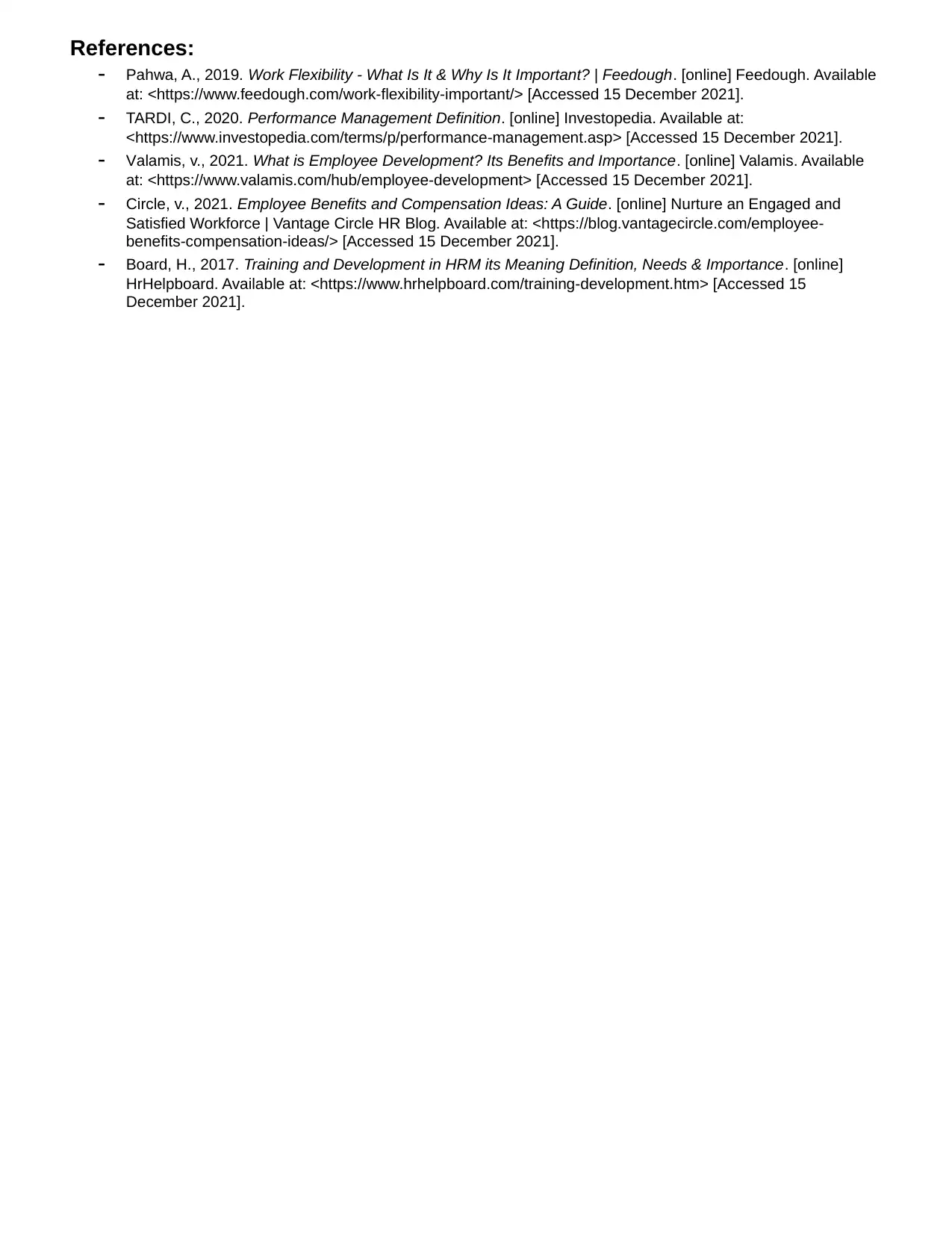
References:
- Pahwa, A., 2019. Work Flexibility - What Is It & Why Is It Important? | Feedough. [online] Feedough. Available
at: <https://www.feedough.com/work-flexibility-important/> [Accessed 15 December 2021].
- TARDI, C., 2020. Performance Management Definition. [online] Investopedia. Available at:
<https://www.investopedia.com/terms/p/performance-management.asp> [Accessed 15 December 2021].
- Valamis, v., 2021. What is Employee Development? Its Benefits and Importance. [online] Valamis. Available
at: <https://www.valamis.com/hub/employee-development> [Accessed 15 December 2021].
- Circle, v., 2021. Employee Benefits and Compensation Ideas: A Guide. [online] Nurture an Engaged and
Satisfied Workforce | Vantage Circle HR Blog. Available at: <https://blog.vantagecircle.com/employee-
benefits-compensation-ideas/> [Accessed 15 December 2021].
- Board, H., 2017. Training and Development in HRM its Meaning Definition, Needs & Importance. [online]
HrHelpboard. Available at: <https://www.hrhelpboard.com/training-development.htm> [Accessed 15
December 2021].
- Pahwa, A., 2019. Work Flexibility - What Is It & Why Is It Important? | Feedough. [online] Feedough. Available
at: <https://www.feedough.com/work-flexibility-important/> [Accessed 15 December 2021].
- TARDI, C., 2020. Performance Management Definition. [online] Investopedia. Available at:
<https://www.investopedia.com/terms/p/performance-management.asp> [Accessed 15 December 2021].
- Valamis, v., 2021. What is Employee Development? Its Benefits and Importance. [online] Valamis. Available
at: <https://www.valamis.com/hub/employee-development> [Accessed 15 December 2021].
- Circle, v., 2021. Employee Benefits and Compensation Ideas: A Guide. [online] Nurture an Engaged and
Satisfied Workforce | Vantage Circle HR Blog. Available at: <https://blog.vantagecircle.com/employee-
benefits-compensation-ideas/> [Accessed 15 December 2021].
- Board, H., 2017. Training and Development in HRM its Meaning Definition, Needs & Importance. [online]
HrHelpboard. Available at: <https://www.hrhelpboard.com/training-development.htm> [Accessed 15
December 2021].
⊘ This is a preview!⊘
Do you want full access?
Subscribe today to unlock all pages.

Trusted by 1+ million students worldwide
1 out of 6
Related Documents
Your All-in-One AI-Powered Toolkit for Academic Success.
+13062052269
info@desklib.com
Available 24*7 on WhatsApp / Email
![[object Object]](/_next/static/media/star-bottom.7253800d.svg)
Unlock your academic potential
Copyright © 2020–2025 A2Z Services. All Rights Reserved. Developed and managed by ZUCOL.





